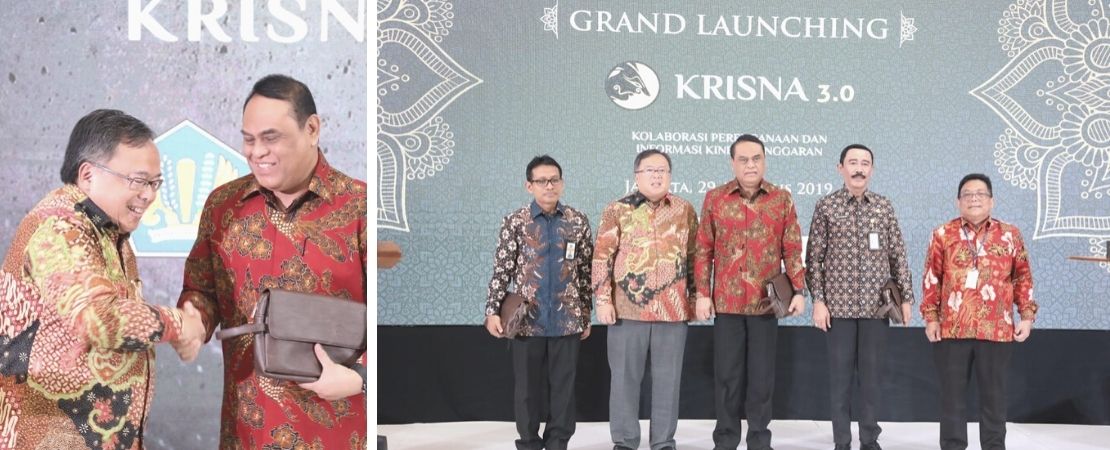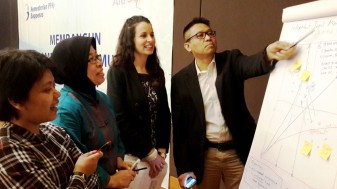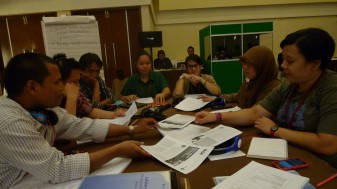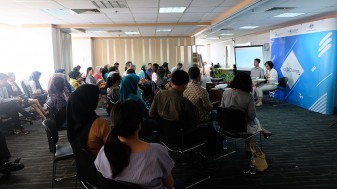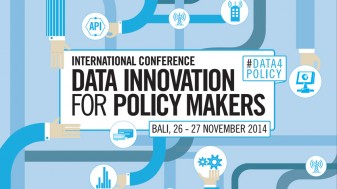Thanks to KRISNA, the government planning and budgeting process has become easier and more integrated. KRISNA continues to be improved to strengthen the accountability and efficiency of Indonesian Government’s performance management.
Since 2016, the Australian Government through the Knowledge Sector Initiative (KSI) has provided support to the Ministry of National Development Planning/Bappenas for the development and integration of an e-planning information system managed by Bappenas. With KSI’s support, this effort produced the Planning and Budget Performance Information Collaborative (KRISNA) platform which has supported government planning and budgeting process since it was first launched in mid-2017.
KRISNA continues to be developed and improved. KRISNA started off as a platform for ministries and agencies to revise and update their development plans in support of the National Priorities, with direction, support and approval from Bappenas and the Ministry of Finance. In 2018, KRISNA was further improved by adding the Government Work Plan (RKP) and infrastructure Special Allocation Fund (DAK) sub-systems. At this stage, KRISNA already had interoperability capabilities that allowed sharing of data between agencies, including identification of output components for integration with related planning systems at the regional level.
To ensure the sustainability and independence of KRISNA management, since 2019 the budget for KRISNA system maintenance has been allocated in the state budget (APBN), while further development of parts of the system continued to get support from other donor programs besides KSI. As a result, as of 2019, KRISNA was equipped with additional features related to the National Medium-Term Development Plan (RPJMN), Strategic Planning (RENSTRA), and others. Since 2020, KRISNA development is fully financed through the state budget. Future developments of KRISNA involves further integration with other agency platforms to enable interoperability, such as between KRISNA and Ministry of Finance’s SAKTI (Agency-Level Financial Application System).
“KRISNA has been used as a reference in the preparation of the Ministry/Agency Budget and Work Plan (RKAKL). However, the KRISNA or Ministry/Agency Work Plan data used by SAKTI is only limited to nomenclature, necessitating manual re-input for budget allocations and work plan targets to be used comprehensively,” said the Leonard V.H. Tampubolon, Deputy for Development Funding at the Ministry of National Development Planning/Bappenas. He said that Bappenas also needs feedback from the SAKTI system to KRISNA to perform its function in ensuring development programs achieve the intended goals. With better interoperability, Bappenas can monitor the progress of national priorities in real time and in greater detail.
Vivi Yulaswati, Expert Staff of the Minister of National Development Planning/Bappenas for Social Affairs and Poverty Alleviation, also spoke of the importance of SAKTI and KRISNA interoperability. This is important when making adjustments or adaptations in the process of development plan implementation. He added, “Interconnection between government systems is already there. But if there are changes after budgeting is implemented by a ministry or agency, the current system has not been designed to automatically input the corrections to RENJA. So planning and budget deviations still occur”.
In terms of data utilization and analysis, KRISNA can further be improved with the development of the KRISNA Data Analysis Dashboard. Currently, KSI is piloting such a dashboard to support ministries/agencies and local governments in utilizing and analyzing KRISNA data to inform evidence-based policies. Himawan Hariyoga Djojokusumo, Chief Secretary of Bappenas, explained that the information in the KRISNA Dashboard is the result of thematic analysis tailored to the needs of the relevant work units to refine future development planning. The thematic dashboards currently being piloted include dashboards for the Directorate of Industry, Tourism and Creative Economy, as well as the Directorate of Forestry and Conservation of Water Resources. “After the pilot is completed, we will immediately evaluate and then replicate its use in other sectors and work units,” he continued.
Other sectors will also benefit from this dashboard as it can provide information related to the development of national priority programs, activities and projects on demand. The goal is to ensure that the government priority agenda is truly on target and aimed for the public good.
The Director of Industry, Tourism and Creative Economy (IPEK) of Bappenas, Leonardo Adypurnama alias Teguh Sambodo, hopes that KRISNA can become a learning application for development planners and budget managers. As KRISNA is also a knowledge repository of the results of development policies from previous years, Bappenas can inform new initiatives, strategies and government interventions, including the necessary policy budgets, with learning of past performance. He added, “In the future, KRISNA can be used as a tool to process and sort budgets, so Bappenas can measure how much budget for the ongoing program, be it expansion or simplification, is needed based on previous year's evaluation.” If this knowledge repository function is realized, he hopes that KRISNA can further be equipped with a monitoring and evaluation system, thus completing the planning cycle – from initial input, budget allocation, work program planning, updating work programs, to implementation evaluation.
Bappenas expects KRISNA development to be completed in 2022. According to Erwin Dimas, Director of Development Funding Allocation (APP), there will be ‘Three Mores’ to be achieved in KRISNA’s future development – More Easy, More Integrated, and More Controllable. ‘More easy’, because user access is extended through a dashboard that provides thematic data. The KRISNA user base will also be expanded so that feedback and input on development programs can be used as evaluation and improvement for the next cycle. “More integrated”, because KRISNA does not only compile details of priority programs, but also programs from all funding sources, and is interoperable with other platforms. This allows users to view data in real time and can be used to improve development planning and budgeting.
The Government Procurement Policy Agency (LKPP), as the administrator of the General Procurement Information System (SiRUP), also hopes that KRISNA can facilitate their procurement management activities. According to Roni Dwi Susanto, the Head of LKPP, the LKPP system is currently able to pull data from KRISNA but it could not be synchronized with the SiRUP database because data updating still needs to be done manually. He expressed his hope that, “If there is a change in terms of ministry/agency budget work plan, KRISNA data can also be updated in real time so that LKPP can immediately synchronize data related to procurement plans in each ministry/agency”.
The arrival of KRISNA in 2017 has provided a foundation for improving the planning and budgeting system in Indonesia. Improving the KRISNA application can make the process of planning and budgeting, even evaluation, more integrated and easier for the government, thus improving accountability and efficiency of government’s performance management and achieving national development goals.

